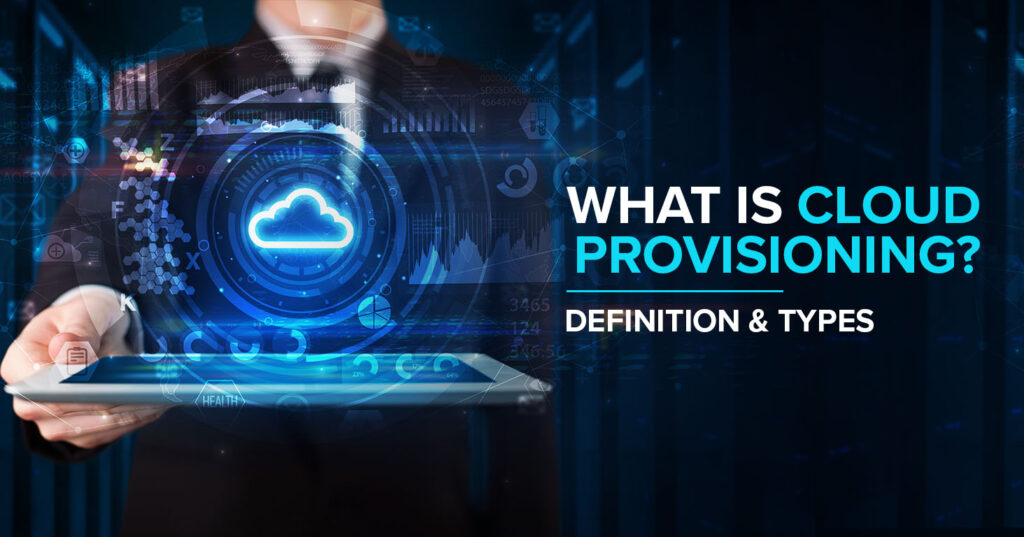What is Cloud Provisioning? Definition & Types
14 +
Years of Experience
550 +
Happy Customers
250 +
Years of Tech Leadership Exp.

"License Reseller" and "Consulting & Implementation" Partner

Cloud provisioning is a crucial element in cloud computing as it deals with the deployment, configuration, and management of resources in the cloud. This allows businesses to allocate computer power, storage space, and other resources whenever required. Such elasticity is critical for running modern IT operations and guarantees resource efficiency and scalability.
What Is Provisioning In IT?
Provisioning is when an IT network is made ready to provide new cloud integration services to its users. The setup may involve installing elements such as hardware or software, thus guaranteeing the smooth running of systems. From this stage, different activities ranging from initial setup to ongoing administration take place.
What Is The Difference Between Provisioning And Configuration?
Provisioning and configuration serve different functions:
- Provisioning: It involves aspects of preparation together with the allocation of resources at the first stage. That is why every hardware and software required is now available.
- Configuration: This refers to what happens when you make your software and system work a certain way by adjusting necessary preferences and settings, which will enable it to perform best for you.
What Is The Difference Between Provisioning And Deploying?
There are major contrasts between provisioning and deploying in information technology:
- Provisioning: It encompasses all activities aimed at setting up infrastructure together with the necessary resources for such infrastructure.
- Deployment: This refers to the act of placing an application or system into a live environment where it becomes operational and ready for use.
What Are The Types Of Provisioning?
The types of provisioning include but are not limited to;
- Manual Provisioning: A method through which IT administrators manually provision their own resources. However, delays associated with manual processes can lead to errors/inefficiency issues.
- Automated Provisioning: Automation tools and scripts can be employed to streamline the provisioning process that replace manual intervention wherever possible.
- Dynamic Provisioning: For dynamic workloads, a resource-on-demand approach is adopted here.
- User Self-Provisioning: Consists of giving people the power to do this on their own, which makes them agile and lifts the load from IT.
What is Cloud Provisioning?
Cloud provisioning is a very important part of cloud computing since it involves the act of bringing in and managing the different resources that are found in the cloud. This implies that businesses can allocate their computer power, storage space, and other resources at will. It is through elasticity like this that modern IT operations can be run, thereby ensuring resource efficiency and scalability.
Types of Cloud Provisioning
Primary types of cloud provisioning include:
- User Self-Provisioning: Allows users to buy cloud integration services directly from the providers and manage them by themselves.
- Advance Provisioning: Resources are acquired in advance based on earlier predictions, thereby making sure that they are ready when needed.
- Dynamic Provisioning: Real-time-based allocation of resources according to current demand for scaling purposes.

Benefits of Cloud Provisioning
The following are the benefits of cloud provisioning:
- Scalability: Scaling up or down resources depending on demand is a straightforward task.
- Cost Efficiency: Cost-effective pay-as-you-go models. They charge for what one utilizes only.
- Flexibility: Flexible allocation capabilities for business agility.
- Improved Resource Management: Use automation tools to manage all sorts of intelligence resources well.
Challenges of Cloud Provisioning
Despite its benefits, cloud provisioning also presents challenges:
- Complexity – Managing a large number of resources can be complex.
- Security – There must be security during the process.
- Cost management – Uncontrolled resource allocation results in unexpected costs.
- Skill gaps – This requires skilled personnel to manage and optimize these effectively.
Cloud Provisioning Tools and Software
Several tools and software exist to facilitate cloud provisioning. These include;
- Terraform: An open-source tool used for building, changing, and versioning infrastructure.
- AWS CloudFormation: This is for developers who want to create AWS resources using code templates.
- Azure Resource Manager: This lets you deploy Azure services so you can manage them.
- Google Cloud Deployment Manager: It is used to configure and deploy Google Cloud’s resources.
How to Automate Provisioning?
Automating provisioning is done using scripts, as well as tools, that can help streamline resource setup and administration. These steps include:
- Define IaC (Infrastructure as Code): Utilize technologies such as Terraform or Azure Resource Manager (ARM) templates to define infrastructure. This allows for repeatable, consistent setups that minimize the chances of human error.
- Implement CI/CD: A method for the provisioning of resources and automatic setup of configurations through a turn-key deployment pipeline. You could achieve an entire automated process by linking it to your IaC definitions in tools such as Jenkins, Azure DevOps, or GitHub Actions.
- Monitor and Optimize: Employ operation efficiency indicators monitoring software and optimize respective areas. These tools include cloud integration services such as Azure Monitor or AWS CloudWatch that allow for better monitoring of resource performance tracking utilization within all environments.
Provisioning Automation with Azure
A typical process involves defining infrastructure using ARM templates.
- Define infrastructure with code using ARM templates, which indicate what resources to have and how the applications should be configured.
- Setting up CI/CD Pipelines in Azure DevOps: With Azure DevOps, you can easily build, test, and deploy your applications effectively. It is integrated into your CI/CD pipeline, meaning that it automates the entire process from application code to infrastructure deployment, ensuring a smooth and efficient workflow.
- Monitoring and Optimization with Azure Monitor: Observe how your resources are performing and healthy through Azure Monitor, for example, optimizing resource allocation or efficient usage of the system.
Leveraging Azure’s cloud integration services allows you to simplify the provisioning process, minimize manual intervention, and maintain an optimized regular configuration of your resources. Beyond enhancing operational efficiency, this strategy also results in reliable and scalable infrastructure for a better user experience.
Cloud Provisioning Models
In broad terms, we classify cloud provisioning models into:
- Public Cloud: These are resources provided by an outside party that serves various users.
- Private Cloud: They offer more control and security because they are dedicated to a single organization.
- Hybrid Cloud: It merges public and private cloud resources to get benefits from both worlds.
How DevTools Help in Cloud Provisioning?
Development tools are very important in the cloud provisioning process for repetitive task automation, manual error reduction, and provision of consistency to environments using infrastructure as code (IaC). This promotes collaboration among the development teams by incorporating version control into it and making continuous cloud integration services and deployment possible. Moreover, DevTools enable monitoring, hence helping to track resource usage as well as performance to optimize the provisioning of cloud resources. They simplify the process of setting up and managing cloud resources, thereby improving overall efficiency and dependability.
Conclusion
Thus, cloud provisioning has become an integral component of the contemporary IT landscape, aiding businesses in effectively allocating their resources in a cost-saving manner. Therefore, having a better understanding of what types of cloud provisioning are available. Alongside their benefits and limitations, it will ensure that organizations can utilize changing cloud technology correctly, depending on their needs. These automation tools, together with DevTools, lead to superior provisioning as they optimize resource utilization while efficiently managing them. Mastering cloud provisioning is key for firms intending to stay competitive in the digital sphere since new technologies keep emerging with time.




